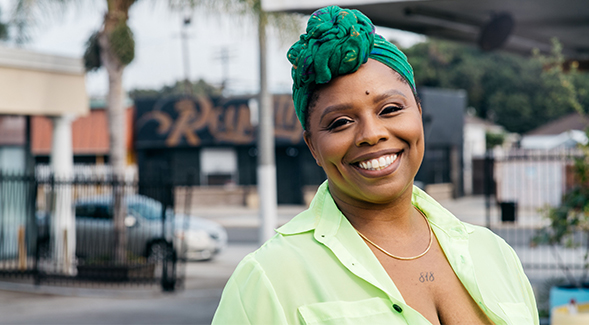
Black Lives Matter co-founder, Patrisse Cullors spoke to San Diego State students about Black Lives Matter through a virtual Q&A on August 23. The event was organized by One SDSU Community, a committee that focuses on diversity and awareness amongst students.
When Patrisse Cullors was 15 years old, she came out as queer. In high school, she started her first protest against her administration’s homophobia, collecting thousands of signatures from classmates and organizing a hallway “kiss in” for queer couples.
This experience would be her first of many, and the first time that she recognized the power of a collective.
Twenty years later, Cullors began Black Lives Matter, a movement that has gained worldwide support and prompted thousands of protests against racially motivated violence.
Black Lives Matter began as a Twitter hashtag in 2013. Now the movement has become a global organization that advocates for defunding the police, decarceration and other reforms.
The Q&A was led by Associated Students President Christian Holt and Paige Hernandez, director of student retention and success for SDSU’s Center of Intercultural Relations.
Cullors began the discussion by addressing what prompted the start of BLM. The movement began in response to the killing of Trayvon Martin, but Cullors said that there was a need for a new Black organization that touched the hearts of a younger generation.
“We really started it from a place of deep desire and longing to talk about Blackness in a different way,” Cullors said. “We recognized as young people that the ways in which the civil rights movement was being discussed were really archaic.”
Cullors emphasized that there was a need for awareness on a global level.
“We needed to create and help build a project that would not just speak to Black folks inside of the United States, but to Black people across the globe,” Cullors said. “Anti-black racism is not just a phenomenon of the United States.”
Cullors also discussed how George Floyd’s death in May has sparked growth within the movement, and how the movement has gained support from more than just the Black community.
“This time around we saw way more people outside of Black people showing up for Black lives,” Cullors said. “We can truly call it a multi-racial movement led by Black people. That wasn’t the case before, it was largely Black people at protests.”
Cullors offered advice to student activists, urging them to join an organization or party for the cause they support. She also emphasized the power of social media to spread awareness.
As for institutions, such as SDSU, Cullors urges authorities to listen to the needs of students of color in order to create a conscious environment.
“It’s the institution’s job to listen to their students, and especially their students at the margins, students of color,” Cullors said. “And in that listening, developing a plan of action. That should really come from Black students in particular.”
Cullors is also known for her work with the “Yes on R” campaign that calls for reform in Los Angeles jails. She said that her experience growing up in a community with over-policing was one of the reasons she devoted her life to activism.
Despite being the co-founder, Cullors said that the future of BLM is up for the people to decide, not herself. While she has no say in the movement’s future, Cullors said that she will remain committed to BLM “no matter what shape or form it takes.”
“Change takes a lot of time,” Cullors said. “While I can’t foresee that we will have all we need and desire in this lifetime, I think we are so much further than what I thought we would be as a movement and as a country.”






